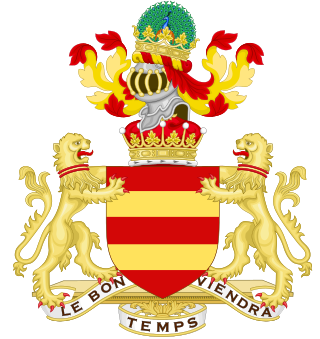
Earl Harcourt, of Stanton Harcourt in the County of Oxford, was a title in the Peerage of Great Britain. It was created in 1749 for Simon Harcourt, 2nd Viscount Harcourt. He was made Viscount Nuneham at the same time, also in the Peerage of Great Britain. Harcourt was the son of the Honourable Simon Harcourt and the grandson of Simon Harcourt, Lord High Chancellor of Great Britain, who had been created Baron Harcourt, of Stanton Harcourt in the County of Oxford, on 3 September 1711, and Viscount Harcourt, of Stanton Harcourt in the County of Oxford, on 24 July 1721. Both these titles were also in the Peerage of Great Britain.

Staffordshire is a landlocked county in the West Midlands of England. It adjoins Cheshire to the north west, Derbyshire and Leicestershire to the east, Warwickshire to the south east, West Midlands and Worcestershire to the south, and Shropshire to the west. The historic county of Staffordshire includes Wolverhampton, Walsall, and West Bromwich, these three being removed for administrative purposes in 1974 to the new West Midlands authority. The resulting administrative area of Staffordshire has a narrow southwards protrusion that runs west of West Midlands to the border of Worcestershire. The city of Stoke-on-Trent was removed from the admin area in the 1990s to form a unitary authority, but is still part of Staffordshire for ceremonial and traditional purposes.
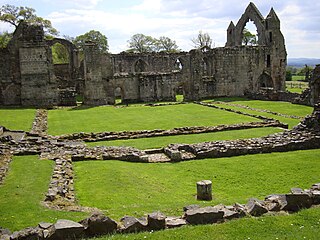
Haughmond Abbey is a ruined, medieval, Augustinian monastery a few miles from Shrewsbury, England. It was probably founded in the early 12th century and was closely associated with the FitzAlan family, who became Earls of Arundel, and some of their wealthier vassals and allies. It was a substantial, successful and wealthy house for most of its four centuries, although evidence of abuses appeared before its dissolution in 1539. The buildings fell into disrepair and the church was largely destroyed, although the remains of some of the domestic buildings remain impressive. The site is now in the care of English Heritage and is open to the public throughout the year and free entry.
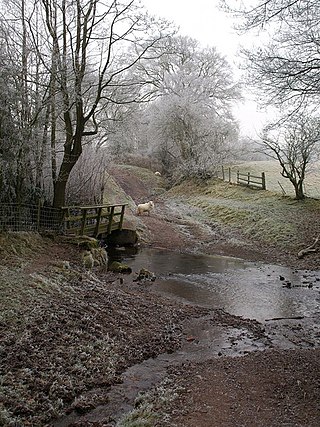
Ratlinghope is a hamlet and civil parish in Shropshire, England. The population of the civil parish at the 2011 census was 138. It is situated four miles (6 km) west of Church Stretton and twelve miles (19 km) south of Shrewsbury.

Burscough Priory, at Burscough, Lancashire, England, was an Augustinian foundation, established in around 1190 and dissolved in around 1536. Some remains of the church survive.
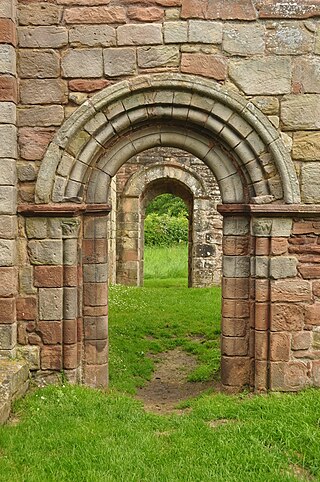
White Ladies Priory, once the Priory of St Leonard at Brewood, was an English priory of Augustinian canonesses, now in ruins, in Shropshire, in the parish of Boscobel, some eight miles (13 km) northwest of Wolverhampton, near Junction 3 of the M54 motorway. Dissolved in 1536, it became famous for its role in the escape of Charles II of England after the Battle of Worcester in 1651. The name 'White Ladies' refers to the canonesses who lived there and who wore white religious habits.

Thomas William Anson, 1st Earl of Lichfield PC, previously known as The Viscount Anson from 1818 to 1831, was a British Whig politician from the Anson family. He served under Lord Grey and Lord Melbourne as Master of the Buckhounds between 1830 and 1834 and under Melbourne Postmaster General between 1835 and 1841. His gambling and lavish entertaining got him heavily into debt and he was forced to sell off the entire contents of his Shugborough Hall estate.
This is a list of the sheriffs and high sheriffs of Staffordshire.

Ranton is a small hamlet in Staffordshire, England, situated 3.5 miles (5.6 km) west of Stafford, 2.5 miles (4.0 km) east of Woodseaves and 2 miles (3.2 km) northeast of Gnosall. The population taken at the 2011 census was 382. As of 2013, both public houses that once operated in Ranton were bought and subsequently removed from operation. Due to this, Ranton is now listed as a hamlet.

Ellenhall is a small Staffordshire village roughly 2.5 miles south of Eccleshall originally comprising part of the extensive estates of the Earl of Lichfield. The population as taken at the 2011 census was 144. The village consists of a scattered community of cottages, a hall, and several farms. Ellenhall has no shop, public house or post office.

Lilleshall Abbey was an Augustinian abbey in Shropshire, England, today located 6 miles (9.7 km) north of Telford. It was founded between 1145 and 1148 and followed the austere customs and observance of the Abbey of Arrouaise in northern France. It suffered from chronic financial difficulties and narrowly escaped the Dissolution of the Lesser Monasteries in 1536, before going into voluntary dissolution in 1538.
Priory of St. Thomas near Stafford was an Augustinian religious house near Stafford, Staffordshire, England. Founded sometime in approximately 1174, it was a surrendered to the Crown in 1538, during the Dissolution of the Monasteries.
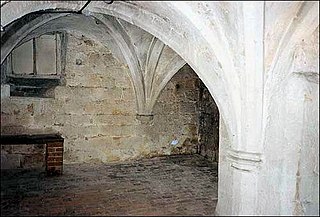
Stone Priory was a priory founded at Stone in Staffordshire, England, in about 670 AD. The priory's church was dedicated to Saint Mary and Saint Wulfad, a local seventh-century martyr and supposedly a son of King Wulfhere of Mercia, who ruled from 658 until his death in 675. The mid-15th century Rimed Chronicle of Stone Priory, found at the Priory at the Dissolution of the Monasteries, records the founding legend and the names of the Stafford family patrons up to 1403, and the places of their burials.
Trentham Priory was a Christian priory in North Staffordshire, England, near the confluence between the young River Trent and two local streams, where the Trentham Estate is today.

St Andrew's Church is a redundant Church of England parish church in the village of Wroxeter, Shropshire, England. It is recorded in the National Heritage List for England as a designated Grade I listed building, and is under the care of the Churches Conservation Trust. Both the village of Wroxeter and the church are in the southwest corner of the former Roman town of Viroconium.

Abbey House is an early 19th-century ruined stately home in Ranton, Staffordshire, England.
William FitzAlan (1105–1160) was a nobleman of Breton ancestry. He was a major landowner, a Marcher lord with large holdings in Shropshire, where he was the Lord of Oswestry, as well as in Norfolk and Sussex. He took the side of Empress Matilda during the Anarchy and underwent considerable hardship in the Angevin cause before regaining his lands and former status. William's younger brother, Walter fitz Alan, became ancestor of the royal House of Stuart.
Ellenhall is a civil parish in the Borough of Stafford, Staffordshire, England. It contains five listed buildings that are recorded in the National Heritage List for England. Of these, two are at Grade II*, the middle of the three grades, and the others are at Grade II, the lowest grade. The parish contains the villages of Ellenhall and Ranton and the surrounding countryside. The listed buildings consist of a church, a cross in the churchyard, the surviving tower of an abbey church, a house, and a milepost.















